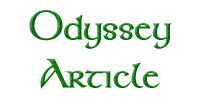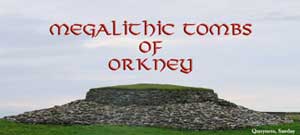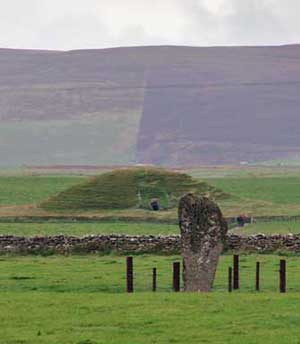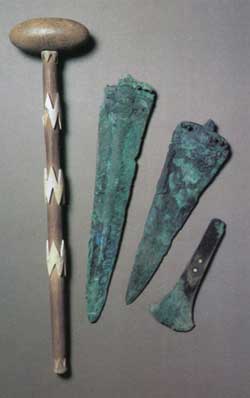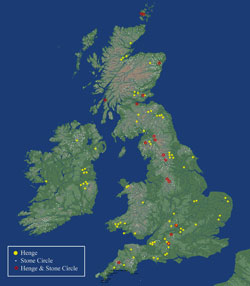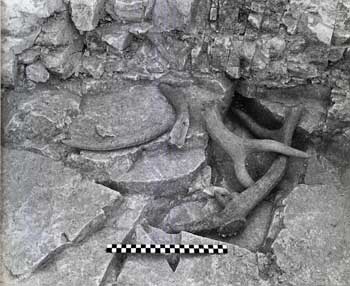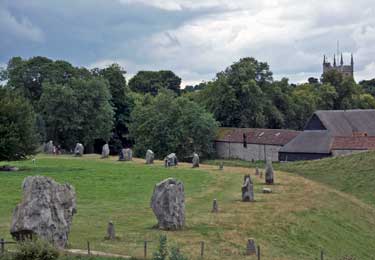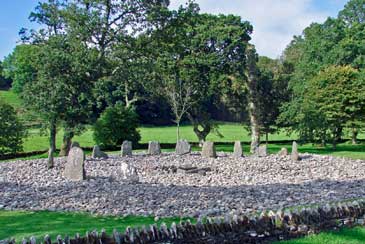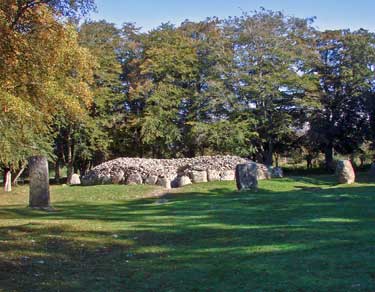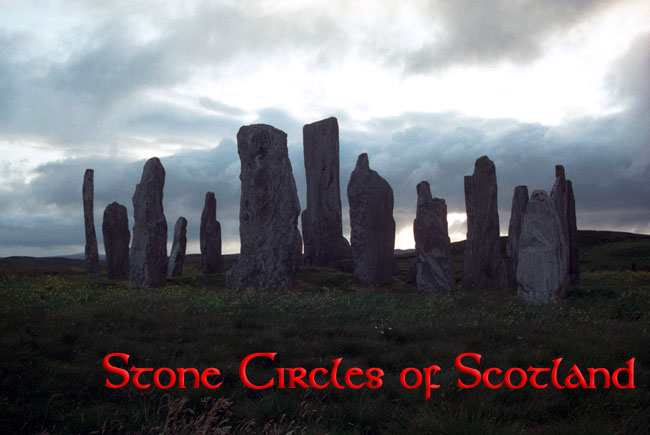
Stone Circles are a type of monument largely confined to the British Isles—although related stonesettings, such as the stone rows at Carnac inBrittany shown (below right), were erected all along the Atlantic façade of western Europe during the period commonly known as theMegalithic Age. In Britain and Ireland some 1,300 of them have been 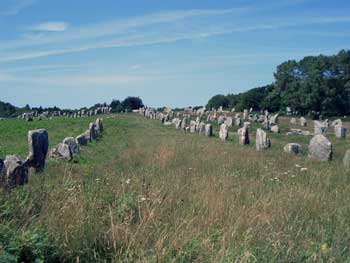 identified, all built between about 3500 and 1200 BC. Most of the surviving examples come from the highland zones of both islands but they are by no means uncommon elsewhere. In fact, the most famous stone circles of all—Stonehenge and Avebury—are both in the lowlands. The distribution may simply reflect the availability of suitable stone and the greater likelihood of survival in upland areas, which were not brought under the plough. At both of the above-named sites, the earliest circles were made of wooden posts and it is rapidly becoming clear that similar timber structures were much more common than had been supposed. Given the nature of the material—wood rots, leaving only an impression in the subsoil—they are far less easy to detect than the stone versions and ploughing may well have obliterated hundreds of them.
identified, all built between about 3500 and 1200 BC. Most of the surviving examples come from the highland zones of both islands but they are by no means uncommon elsewhere. In fact, the most famous stone circles of all—Stonehenge and Avebury—are both in the lowlands. The distribution may simply reflect the availability of suitable stone and the greater likelihood of survival in upland areas, which were not brought under the plough. At both of the above-named sites, the earliest circles were made of wooden posts and it is rapidly becoming clear that similar timber structures were much more common than had been supposed. Given the nature of the material—wood rots, leaving only an impression in the subsoil—they are far less easy to detect than the stone versions and ploughing may well have obliterated hundreds of them.
Chambered Tombs
The earliest circles date to the latter part of the Neolithic period, which had begun with the introduction of agriculture into the islands some thousand years earlier. They were the culmination of a tradition of large-scale monuments that was first expressed in the construction of communal tombs-barrows and passage graves. Because they had invested an enormous amount of time and energy into the land, these early farmers were very territorial in their thinking. Their communities were quite small, no more than a few closely related families, and pretty much self-sufficient. The site of Skara Brae in the Orkneys is a wonderfully preserved example of such a village. To stake their claim each group built a visible tomb into which they placed the bones of their ancestors. The tomb advertised to all who passed by that this was their land as it had been the land of their fathers.
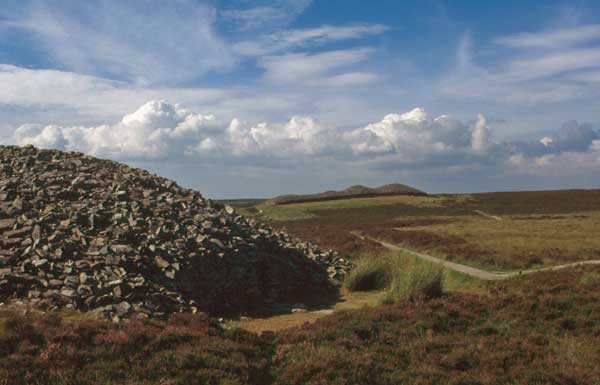
The Grey Cairns of Camster
It was the spirits of the ancestors who meditated on behalf of the group with the forces that controlled their destiny. Like all farmers, their principal concerns were with the weather and the fertility of their flocks and fields. Their lives were controlled absolutely by the seasons and they marked their change with communal rituals held at the tomb. The tombs themselves appear to have been oriented towards major celestial events occurring in the heavenly arc running from the northeast to the southeast that marks the limits of the sunrise and moonrise. By observing these events, people were able to predict the change of seasons with a fair degree of accuracy and plan their agricultural routine.
In Scotland, the tombs are stone built, chambered cairns with an entrance passage. The exact type of tomb varied from one part of the country to the other. Some were long and trapezoidal in shape with an 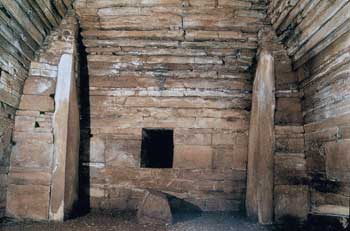 out-curved façade at one end, forming a sort of forecourt that could be used for ritual activities, while others were circular and much simpler in design. Some had single chambers; others were sub-divided. The most impressive example is the enormous passage grave at Maes Howe in the Orkneys (left). It is a huge circular mound of stone and turf some 40 metres across and over 8 metres high.
out-curved façade at one end, forming a sort of forecourt that could be used for ritual activities, while others were circular and much simpler in design. Some had single chambers; others were sub-divided. The most impressive example is the enormous passage grave at Maes Howe in the Orkneys (left). It is a huge circular mound of stone and turf some 40 metres across and over 8 metres high.
The interior is a magnificent, carefully shaped chamber with a high, corbelled roof at the end of a long passage. The central chamber has three side cells, each with a small hatchway originally sealed with a block of stone. The passage runs to the southwest and is directly aligned with the midwinter sunset. Unfortunately, it had been broken into a number of times in the past and virtually all trace of its original contents are gone but several of its smaller neighbours contained the remains of a number of individuals along with some broken pottery and tools.
The building of Maes Howe marked both the peak of the passage grave tradition in Scotland and its end. As more and more land was brought under cultivation, the population steadily increased and new social arrangements appeared. At some point around the latter part of the fourth millennium 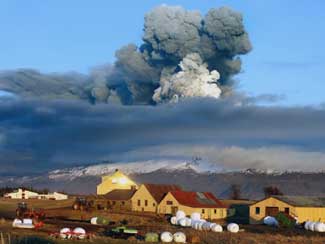 BC, the climate appears to become decidedly wetter and cooler, which would have had a disastrous effect on living conditions. A possible cause may have been a huge volcanic eruption in Iceland, which would have produced dense, ash-laden clouds, as the recent eruption of Eyjafjallajökull (right) has clearly demonstrated. These would have blocked the sun and saturated the landscape with rain. The growing season would have been reduced and land that had formerly been productive was now either waterlogged or severely eroded. Much of it was abandoned and reverted to scrub or forest. All of this would have led to famine, a sharp drop in population and a profound “crisis of faith” among the survivors.
BC, the climate appears to become decidedly wetter and cooler, which would have had a disastrous effect on living conditions. A possible cause may have been a huge volcanic eruption in Iceland, which would have produced dense, ash-laden clouds, as the recent eruption of Eyjafjallajökull (right) has clearly demonstrated. These would have blocked the sun and saturated the landscape with rain. The growing season would have been reduced and land that had formerly been productive was now either waterlogged or severely eroded. Much of it was abandoned and reverted to scrub or forest. All of this would have led to famine, a sharp drop in population and a profound “crisis of faith” among the survivors.
Competition over dwindling resources led to conflict between groups and eventually brought about the emergence of more extensive social units—tribes—under the leadership of charismatic individuals whom we call chiefs. Another very important factor was the introduction of metal-working, which occurred around the same time. Metal sources were geographically restricted and the distribution of the finished products was subject to political control. Metals also provided the first real example of wealth that could be hoarded and used to 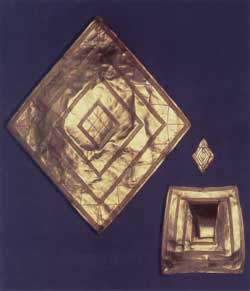 buy political support. Reflecting these developments was a change in burial practices from large, collective tombs to smaller, round barrows with individual burials. Although the tombs were less impressive, the burials were accompanied by an unprecedented amount of wealth—bronze axes and daggers, gold ornaments and necklaces of amber and jet.
buy political support. Reflecting these developments was a change in burial practices from large, collective tombs to smaller, round barrows with individual burials. Although the tombs were less impressive, the burials were accompanied by an unprecedented amount of wealth—bronze axes and daggers, gold ornaments and necklaces of amber and jet.
A good example of this sort of thing is the material unearthed at Bush Barrow near Stonehenge in Wiltshire. The tomb contained the tomb of a solitary male who had been laid to rest with gleaming bronze daggers and axes. He had what appears to be a polished stone mace with a wooden handle decorated with bone mounts. On his chest was a sheet gold lonzenge with chased geometric designs while, at his waist, was a gold belt hook with similar decoration (left).
To mark the new order, large ceremonial centres were constructed to serve as meeting places for the various tribes where they could solidify links with their neighbours through trade and the performance of common ritual activities. In the British Isles, these centres took the form of henges and stone circles, with the former generally found in the lowland zone and the latter in the highlands—although there is some overlap, in Cumbria and the Orkneys for example.
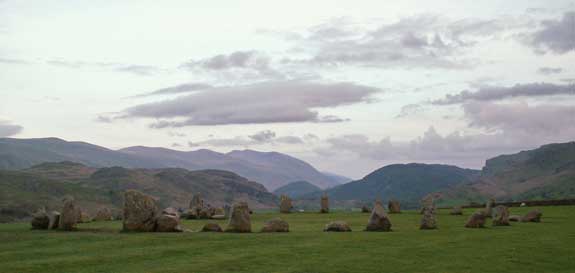
Stone Circle at Castlerigg, Cumbria
In light of their failure to respond to the changing conditions, the power of the ancestors was discredited. In contrast to the earlier megalithic tombs with their collective burials, the new ritual 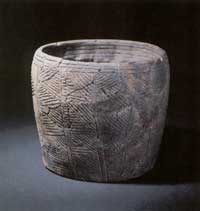 centres open to the sky and emphasize the world of the living rather than the world of the dead. They are more inclusive and are intended to serve as meeting places for a wider network of social and economic groupings.
centres open to the sky and emphasize the world of the living rather than the world of the dead. They are more inclusive and are intended to serve as meeting places for a wider network of social and economic groupings.
Their appearance coincides with the introduction of a new type of pottery known as grooved ware (right) from its characteristic incised decoration. Although it occurs at domestic sites in the Orkney Islands (where many believe it originated) it is generally found at ritual sites (henges; stone circles and tombs) elsewhere in Britain. It has been suggested that the vessels were used for the brewing of beer, which has a long history of facilitating the exchange of goods and ideas in this part of the world.
Henges
One of the characteristic monuments that defines this period in British prehistory is the henge. The term derives from Stonehenge ( the name is generally thought to mean “hanging stones” in Old Anglo-Saxon). However, in archaeological terms, the stones are unnecessary.
A henge is a roughly circular or oval enclosure consisting of a ditch and external bank with one or more entrances. Over 80 examples have been identified in the British Isles ranging in size from some 10 metres in diameter up to 300 metres or more. They are formed by excavating a ditch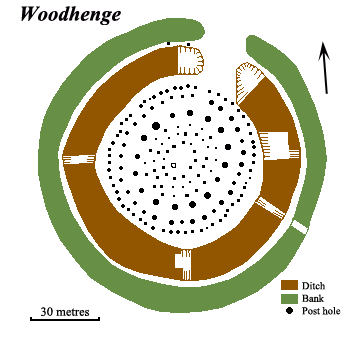 around the perimeter of the enclosure and heaping up the material to form a parallel bank, clearly seen at the site of Avebury. In most cases, the bank is outside the ditch but, ironically, the most glaring exception to the rule is at Stonehenge, the type-site, where the opposite occurs. Each henge had at least one entrance—a simple gap in the ring—and many had two or more. Those with a single entrance, such as Woodhenge (right) are known as Class I henges while those with two or more are Class II. The most common arrangement was a pair of opposed entrances to the northwest and southeast (as it is at Durrington Walls, Wiltshire below), towards the midsummer sunset and the midwinter sunrise, but there are plenty of exceptions. Although there are some quite small ones, the majority of them took far more time and effort to construct than any of the earlier types of monument—far beyond the means of a single small community. Although there are a pair of notable examples in the Orkney Islands, henges are much more common in England than in Scotland where they presumably developed out of an earlier type of enclosure known as a causewayed camp.
around the perimeter of the enclosure and heaping up the material to form a parallel bank, clearly seen at the site of Avebury. In most cases, the bank is outside the ditch but, ironically, the most glaring exception to the rule is at Stonehenge, the type-site, where the opposite occurs. Each henge had at least one entrance—a simple gap in the ring—and many had two or more. Those with a single entrance, such as Woodhenge (right) are known as Class I henges while those with two or more are Class II. The most common arrangement was a pair of opposed entrances to the northwest and southeast (as it is at Durrington Walls, Wiltshire below), towards the midsummer sunset and the midwinter sunrise, but there are plenty of exceptions. Although there are some quite small ones, the majority of them took far more time and effort to construct than any of the earlier types of monument—far beyond the means of a single small community. Although there are a pair of notable examples in the Orkney Islands, henges are much more common in England than in Scotland where they presumably developed out of an earlier type of enclosure known as a causewayed camp.
Where they have been excavated, the terminals of the ditch on either side of the entrances were found to contain offerings tossed there by people entering the site. These included such things as antler picks (used to quarry the ditch), smashed pots, and flint tools. Wooden structures have been found inside a number of henges-large circular 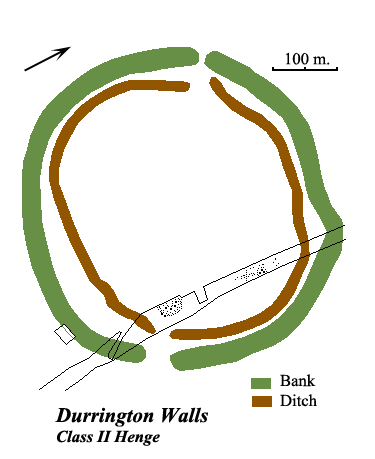 buildings, timber-lined avenues and rows of posts. The interiors of some of the structures were almost entirely filled with concentric rings of posts and produced no evidence of domestic occupation making it difficult to escape the conclusion that they were ritual in function. At several sites, including Stonehenge and at Avebury, the original henge monument was augmented by the addition of circles and alignments of standing stones. Where excavations have taken place it is generally the case that these replaced wooden structures but that was not always the case. A possible motive for their erection may be that they symbolized the economic relationship between highlanders and lowlanders. The refurbished monument combined architectural elements from both regions in order to create a meeting place where both groups could feel at home.
buildings, timber-lined avenues and rows of posts. The interiors of some of the structures were almost entirely filled with concentric rings of posts and produced no evidence of domestic occupation making it difficult to escape the conclusion that they were ritual in function. At several sites, including Stonehenge and at Avebury, the original henge monument was augmented by the addition of circles and alignments of standing stones. Where excavations have taken place it is generally the case that these replaced wooden structures but that was not always the case. A possible motive for their erection may be that they symbolized the economic relationship between highlanders and lowlanders. The refurbished monument combined architectural elements from both regions in order to create a meeting place where both groups could feel at home.
The henges themselves are unlikely to have served as fortifications—an interior ditch would have been a liability to say the least—and probably served as gathering places for the scattered communities of the region where they took part in a variety of activities serving to draw them 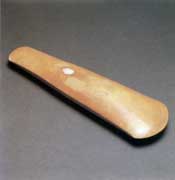 together. These undoubtedly included rituals and ceremonies but the occasion was also used to exchange goods, livestock and marriage partners. It was always desirable to have relatives in other villages, a fallback in case of disaster. In order to thrive, a periodic infusion of fresh blood was necessary for both humans and animals. One item that is associated with both henges and stone circles is the axe, a widely traded item throughout the Neolithic and Bronze Age. Very attractive polished stone versions (right) made from carefully chosen and very specific sources were exchanged at first, gradually giving way to copper and bronze examples. Axes were considered highly desirable status symbols-many of the excavated examples had never been used.
together. These undoubtedly included rituals and ceremonies but the occasion was also used to exchange goods, livestock and marriage partners. It was always desirable to have relatives in other villages, a fallback in case of disaster. In order to thrive, a periodic infusion of fresh blood was necessary for both humans and animals. One item that is associated with both henges and stone circles is the axe, a widely traded item throughout the Neolithic and Bronze Age. Very attractive polished stone versions (right) made from carefully chosen and very specific sources were exchanged at first, gradually giving way to copper and bronze examples. Axes were considered highly desirable status symbols-many of the excavated examples had never been used.
Stone Circles
Current evidence indicates that the earliest circles are to be found in the cemetery at Carrowmore in County Sligo, Ireland and date to the fifth millennium BC— at least a thousand years before they appear in Britain. They tend to be found in the more mountainous areas of the western half of the island. Because of the rough terrain, this region cannot support the same density of population as the lowlands. So stone circles tend to be much smaller than henges, most of them less than 20 metres in diameter.
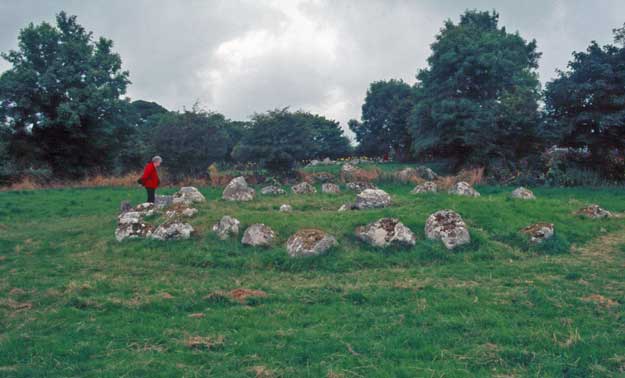
Carrowmore Ireland. Tomb 4
The builders tended to look for a site that was as flat as possible and close to a good supply of stone, preferably of a suitable shape. In Orkney, where the red sandstone easily split, the builders quarried the rock but otherwise they took what was to hand. Its location in relation to the group or groups that used it must have been important too. The small ones would most likely have been used by people from a single village while the larger ones must have served a number of scattered communities. Unfortunately, we do not have enough evidence to do more than speculate on the relationship between the location of the circle and the groups that used it. This is an important issue—especially when two or more sites are close together, such as Brodgar and Stenness in the Orkneys. Were they both built by a single tribe at the centre of their territory or did two tribes each build a circle where their territories met? Only rarely do we have a contemporary settlement that relates to a particular stone circle so we cannot say for sure.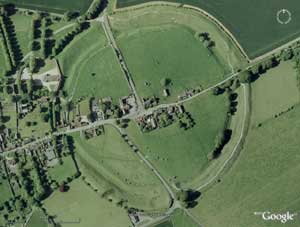
The blocks were then transported, probably using sledges, to the site. The average stone weighed two or three tonnes and could have been handled by a couple of dozen men. The site would have already been cleared of scrub and the shape of the ring outlined. Many of them, such as the one at Avebury (left), were far from circular—some were slightly flattened while others were egg-shaped or elliptical. True circles would have been easy to lay out using a peg and a length of rope and these are most common. We can only speculate why other shapes were chose. It may have been that, owing to the local topography, an odd shape may have appeared more symmetrical. Or perhaps the shape was meant to focus attention of the spectators on the principal actors or on a particular sightline. Some mathematicians like Alexander Thom have argued that the result was a product of precise measurement and Pythagorean principles, it is just as likely that they were simply eyeballed.
Many circles had one or more outlying stones, presumably used as a foresight. Thom also proposed that there was a standard linear measure, the Megalithic Yard (0.83 metres), and that rods exactly that length were used to lay out the ring and the positions of the stones. Some sort of measuring device—whether a rod or a length of knotted rope—must have been used but just how ‘standard’ it was is problematical. It is likely that the unit was based on the human body—a pace or an arm span—and these would be pretty much the same throughout the islands.
At the site, the stone was manoeuvred to its place in the circle where a hole had been dug to receive it. In order to prevent it from eventually toppling, the hole had to be dug to a depth of at least one-quarter the height of the stone. The work would have been very strenuous to say the least. The only tools available would have been flint or stone axes, antler picks and shovels made out of the shoulder blades of oxen. The near side of the hole would have been ramped and then the base of the stone was dragged over the edge until it overbalanced and the base slid into the socket. Next it was hauled upright by gangs of men using ropes and levers and wedged in place with broken rocks and gravel. The number of stones in the final arrangement depended to some extent on the circumference of the circle but local preferences are also apparent—the recumbent circles of Aberdeenshire, of which there are dozens, most often have ten or eleven stones.
Astronomical Alignments
It has been widely claimed that stone circles were designed as astronomical observatories, that the stones were laid out to create sightlines to various celestial objects and events. While it seems pretty clear that solar and lunar alignments were an important factor in the layout of many of the rings, there are real problems when it comes to the stars. For one thing, many stones are missing or have toppled over and it is extremely difficult to fix their original position with any confidence. For another, the positions of the stars in relation to each other is constantly changing over time. Their movements are subject to the laws of physics and we can recreate a map of the heavens for any period in the past. But, in order to draw any conclusions about the orientation of any sightline, we have to know exactly when the stones were erected. Unfortunately, none of the dating methods used, including radiocarbon dating, is accurate enough for that. Finally, there are hundreds if not thousands of combinations of stones at any given site that produce sightlines. These include alignments from stone to stone; from centre point to entrance; from centre point to stone; from circle to outlying stone; from circle to circle; and from circle to some landmark such as a peak or cleft in a line of hills. Given the number of potential targets in the sky, it would have been difficult to miss hitting something significant with at least one alignment.
Moreover, as Aubrey Burl points out:
Added to these archaeological uncertainties are the human beings themselves, subject to all human frailties, idleness, forgetfulness, indifference, misunderstanding, incompetence. A stone circle affected by any of these circumstances would have errors that cannot be realised but which inevitably ruin neat analyses. With resignation researchers must acknowledge that perfection is unachievable.
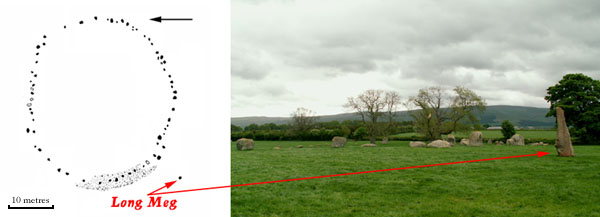
Long Meg & her Daughters
The cycles of the sun and moon were much more significant to early farmers than the positions of the stars. Their regular and predictable movements can be used to create a simple calendar, which would enable them to calculate when to plant their crops. The rising and setting of the sun at the solstices was of enormous significance. Midwinter, when the sun had moved to its southernmost position, was a time of stress in prehistoric communities. There must have been a sense that the sun would not return unless the proper rituals were undertaken and many stone circles have a clear alignment to the sunrise (southeast) or sunset (southwest) at that time of year. At some sites, midsummer was the important time of year while at others it was apparently the great Celtic festivals of Imbolc (February 1st); Beltane (May 1st); Lughnasadh (August 1st); and Samhain (November 1st).
The movements of the moon are far more complex than those of the sun. Its cycle is much shorter-28 days versus 365 days—creating much smaller divisions of time. As it moves in orbit around the earth, it waxes and wanes-disappearing altogether in the middle of its cycle. There is a second lunar cycle that may or may not have been noticed by prehistoric people. The northern and southern extremes of its risings and settings expanded and contracted over a period lasting 18.61 years, not much less than a lifetime for most of them, and it would have taken generations to accumulate the relevant data.
The Function of the Circles
The obvious interpretation of the circles is that they served some sort of ritual function—the standard archaeological answer for things that cannot otherwise be explained. Understanding the nature of the rituals involved, however, is problematical to say the least. What survives, at best, are the settings and a minute fraction of the physical evidence—mainly pottery, stone and bone. Circles are very commonly used among preliterate peoples (as well as modern witches) to mark off sacred space from the perilous world 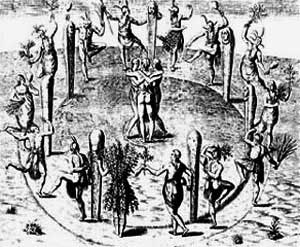 surrounding it.
surrounding it.
Dances and processions around the perimeter are generally part of the ceremonies as are sacrifices and feasting. In pagan Celtic Britain and Ireland, festivals such as these were connected to the rhythms of the land and took place at specific times of the year-planting, harvesting, the lambing season, etc. Many of them, re-dedicated to Christian saints, continue to be celebrated today and there is every reason to suspect that their origins lay even deeper in the past. A number of the Scottish circles are funerary in nature-at least insofar as they were found to contain burials or cremated bone. However, the burials appear to have been secondary to the erection of the stones, belonging to the Beaker Period (ca. 2800-1800 BC).
Dances and processions around the perimeter are generally part of the ceremonies as are sacrifices and feasting. In pagan Celtic Britain and Ireland, festivals such as these were connected to the rhythms of the land and took place at specific times of the year-planting, harvesting, the lambing season, etc. Many of them, re-dedicated to Christian saints, continue to be celebrated today and there is every reason to suspect that their origins lay even deeper in the past. A number of the Scottish circles are funerary in nature-at least insofar as they were found to contain burials or cremated bone. However, the burials appear to have been secondary to the erection of the stones, belonging to the Beaker Period (ca. 2800-1800 BC).
Many are connected with the exchange of stone axes-a number have been found near Avebury and Brodgar. Axes, of course, served a very practical purpose as far as Neolithic farmers were concerned and were used to fell trees and to work the soil but they also appear to have objects of veneration and symbols of status. Many of them had never been used as tools and some, such as the chalk versions found at Woodhenge, were clearly non-functional. Some of the axes appear to have been deliberately buried, a practice that was widespread on the European mainland as well. In later times, axes were identified with the forces of nature and fertility. The fact that, until quite recently, they were generally believed to be thunderbolts, suggests that there may have been a connection with some sort sky or weather god.
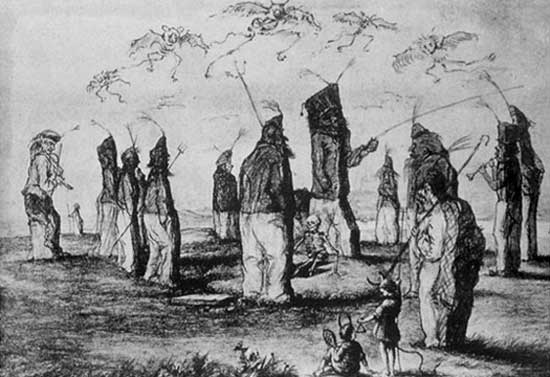
Callanish under the influence of spirits
Local legends concerning several stone circles have it that they were dancers who had been turned into stone for breaking the Sabbath and there may well be some truth in them. Such dances are fairly common in other cultures and groups—not least of which were the witch covens of former days. By all accounts the latter were rapid, frenzied affairs and highly charged with sexual energy. It cannot be proven, of course, but it is highly likely that something quite similar went on in Neolithic times. These may well have been fuelled by drugs and alcohol. It is thought that the tall cylindrical vessels known as beakers, which are associated with the later phases of a number of stone circles, were used to hold mead or beer. Cannabis was available as were a number of hallucinogens such as henbane.
| Armit, Ian | (1996) | Archaeology of Sky and the Western Isles |
| Burl, Aubrey | (1993) | From Carnac to Callanish |
| (2000) | Stone Circles of Britain, Ireland and Brittany | |
| Cunliffe, Barry | (2001) | Facing the Ocean: The Atlantic and its Peoples |
| Garnham, Trevor | (2004) | Lines on the Landscape, Circles from the Sky |
| Richards, Colin (edit.) | (2013) | Building the Great Stone Circles of the North |
| Scarre, Chris | (2007) | The Megalithic Monuments of Britain and Ireland |
| Thom, Alexander | (1970) | Megalithic Lunar Observatories |

